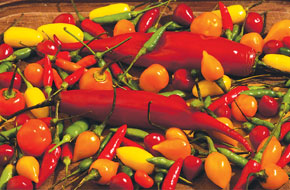
Eduardo CesarColumbus and his sailors were the first Europeans to be introduced to peppers in the AmericasEduardo Cesar
In the 16th century European ships came to the Americas not only in search of Brazilwood and cotton, monkeys and parrots, but also a product that historians have not paid much attention to: peppers of the Capsicum family, including varieties such as dedo-de-moça, piripiri, tabasco, jalapeño, bell and sweet peppers. Originating from Central and South America, they were different from black pepper (Piper nigrum), which was brought from Asia along with cloves, cinnamon and other spices, argue Christian Fausto dos Santos, Fabiano Bracht and Gisele Cristina da Conceição, researchers at the History, Sciences and Environmental Laboratory of the State University of Maringá. Their research is based on reports from chroniclers, physicians and travelers of the time (Bulletin of the Paraense Emilio Goeldi Museum, Humanities, January-April 2013). According to these researchers, Christopher Columbus and his sailors in the 15th century were the first Europeans to be introduced to American peppers, which had been planted in Mexico for 9,000 years and in the Peruvian Andes since 2500 B.C. After Columbus, peppers spread rapidly, and began to be planted in gardens and backyards, initially in the Iberian Peninsula. One report says that the American varieties were more aromatic and flavorful than those from India, then the main spice sought in the East. In another study, the Maringá group reports that peppers were used in food preparation onboard ships to prevent scurvy.
Republish